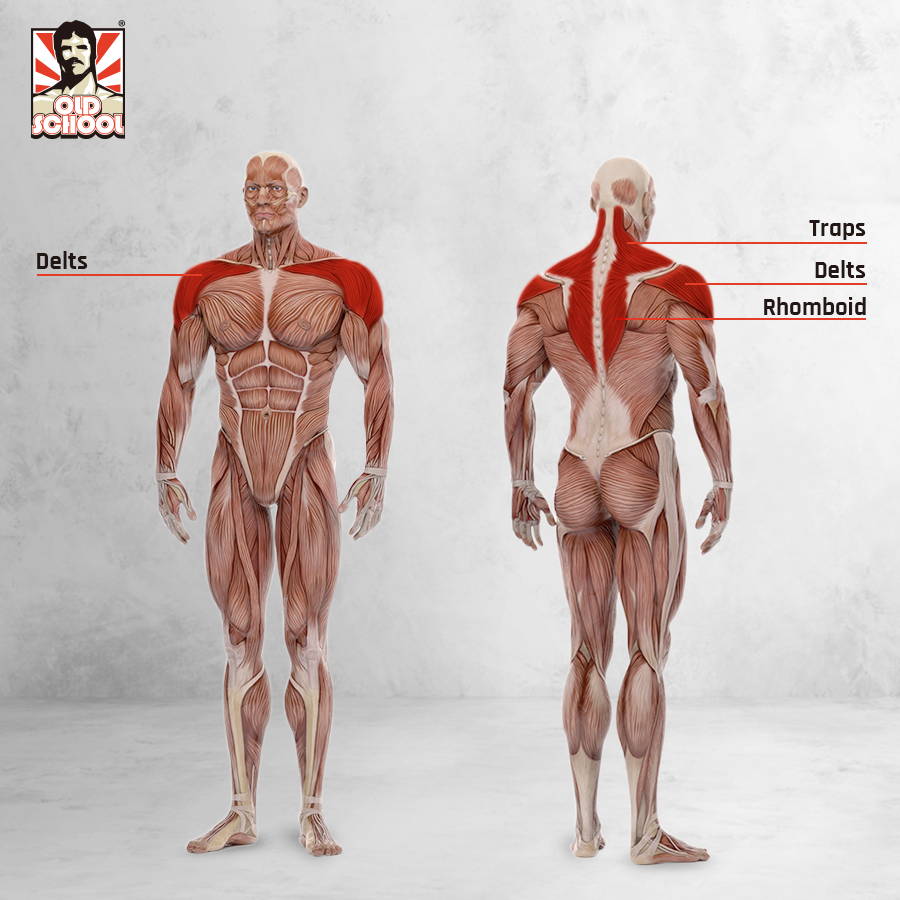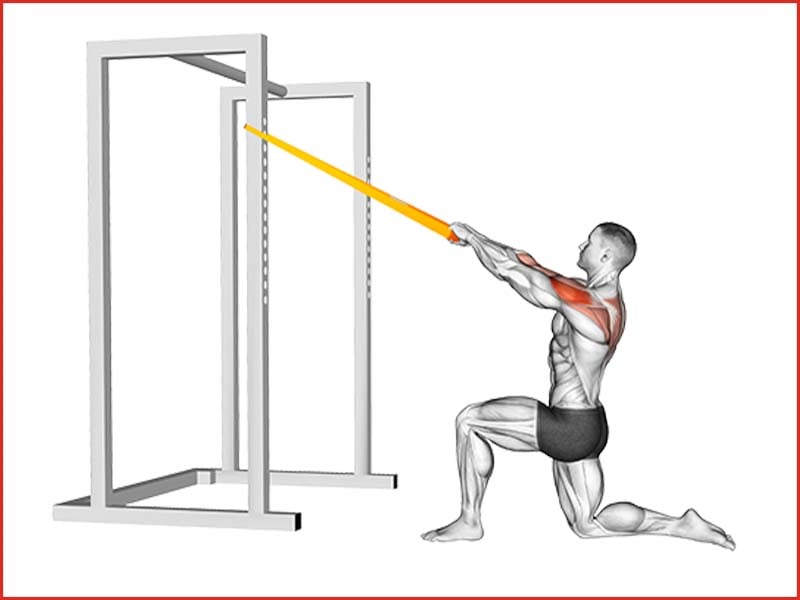
How to do a Face Pull with Proper Form, Tips, & Modifications
Key Takeaways
- Face pulls are a functional movement that works the shoulders, traps, and upper back muscles.
- Performed correctly, this exercise will keep your shoulders healthy and protect them from injury as you go about your day or working hard in the gym.
- If you want to learn proper form for face pulls, plus tips, modifications and alternatives, continue reading below.
Do you suffer from poor posture?
Have you noticed that your shoulders are rounding towards the front, even when not sitting down?
Struggling with your shoulder workouts, or experiencing shoulder pain during or after your workout?
If you answered yes to any of these questions, pay attention to today’s article. It’s all about face pulls, a compound exercise you can use to improve your posture and shoulder mobility.

Face pulls can be done at the gym or at home, with the right equipment. Today, we’ll focus on:
- The most common questions asked about face pulls
- How to perform them correctly
- Ways you can do face pulls at home
- Modifications to the exercise
What Muscles Does the Face Pull Work?

Face pulls are a compound exercise that works the upper back and shoulder muscles. Specifically, the:
- Posterior deltoids
- Traps
- Rhomboids
- Infraspinatus and teres minor muscles of the rotator cuff
The biceps work to flex the elbow joint while the spine erector muscles stabilize the lower back.
What are Face Pulls Good For?
The face pull is considered a functional movement, which works to improve daily life.
It’s especially important for those who sit at a desk for hours every day. Desk-dwellers can end up with poor posture and forward-rounded shoulders.
Enter the face pull, which works not only to strengthen your shoulders but also improve your posture. Face pulls are a great way to improve scapular stability, which will also assist with other upper body workouts.
Are Face Pulls Push or Pull?
As you may have guessed from the name of the exercise, face pulls are a pull exercise. They are a great addition to your upper body routine to balance out other push exercises.
Face pulls are easily included in any exercise routine. If you are doing the push/pull/legs split, include them in your pull day. If you’re working your legs, you can include them as a finisher exercise.

Since the face pull is an exercise that promotes better posture and shoulder health, they are safe to include in each workout. As long as you perform these properly and don’t go overboard on the weight, injury isn’t a worry.
This exercise will actually protect against injury, so perform it properly and often.
Face Pulls with Proper Form
How do you do face pulls? With proper form, the right equipment and the right amount of weight. Let’s talk about equipment before we get into form.
Using the Right Equipment
Face pulls are best done with a cable machine using the rope attachment. Depending on the length of your arms, you may find it’s better to double up the ropes. This involves pulling the rope all the way through and then clipping in another rope to use the full length of each.
If you’re working out at home or don’t have access to a cable machine, you can also use resistance bands. You can attach the band to a sturdy anchor or loop it around an anchored stair rail. In a pinch, you can also make a knot in the center of the band and then shut it in a door.

Face pulls should not be done with dumbbells or other free weights. You need the resistance the cable or band provides to make this functional exercise effective.
To complete the face pull, set up the cable machine or band to be above your head. If this isn’t an option for you, be sure to check out the modifications section for alternative solutions.
You want a weight that will provide resistance when you pull on the rope or band, but not enough to pull you forward. If you can’t stay in position while doing your reps, the weight is too heavy and you need to reduce it.
This is not a power exercise but a functional one, so the weight doesn’t matter.
Proper Form

To perform the face pull properly:
- Stand facing the cable machine and grab the ends of the rope with each hand. Use an underhand grip right above the ball end, with your thumbs facing you.
- Maintain an athletic stance throughout your reps. Feet hip- to shoulder-width apart, slight bend to the knees, core engaged to keep your upper body steady. If a split stance is more comfortable, then use it.
- Position the ropes so that the cable is taught, but the weight hasn’t lifted yet. Your arms should be face height and straight out in front of you.
- Begin by squeezing your shoulder blades and bringing the rope back towards your face.
- Continue to pull the rope back, allowing your hands to move past your ears before your elbows.
- Keep pulling the rope until your hands are past your ears, but before the rope reaches your face.
- Squeeze your shoulders for a second or two before you move your hands back to the starting position.
- Reset your shoulders before you begin the next rep.
Complete two to three sets of face pulls with 8 to 15 reps per set. The amount of reps and sets depends on if this is a finishing move or part of your workout routine. Take up to two minutes to rest between sets as needed.
Face Pulls Tips for Success
In order to get the most benefit from your face pulls, you have to do them right. Use these tips to ensure you’re setting yourself up for success when completing your face pull sets.
1. Anchor Point Matters
You may have seen videos of other people showing face pulls with the anchor point somewhere other than overhead. Some people pull from the face, chest, or even lower.

This is not the proper way to do it, as you get the most benefit from anchoring the cable above your head. If you set your cable anchor lower, these things can happen:
- Higher risk of shoulder injury
- Lack of full external rotation in your shoulder
- Your back will round as your arms are pulled forward and down
If you’re using a cable, then you can anchor the band lower at chest level. However, keep in mind that you want a lighter band or you’ll have to stand closer to the anchor. You would also start with your arms already bent rather than straight out, basically the middle of the movement.
2. Mind Your Grip
The grip you use with the rope attachment is important. You want to use an underhand grip rather than an overhand grip. Grab the ropes so your thumbs are pointing at you and touching the balls at the end.

Using an overhand grip will cause your shoulders to internally rotate, which can cause shoulder injury over time. You’ll also lose some range of motion, which defeats the purpose of the face pull.
3. It’s All in the Name
This is a face pull, after all, so be sure that’s where the rope travels to. Starting at a high point requires you to bring the rope down and back, to travel past your face. The ends of the rope should go past your ears and behind your head as you engage each muscle group.
Remember also that your hands should be moving back before your elbows. Letting your elbows lead will internally rotate the shoulders rather than the desired external rotation.
Think of it this way: you’re bringing your shoulder blades and back muscles closer together as you pull. Your chest is opening up as you engage your rotator cuff and traps to help with the pull.
If you’re having trouble with this, check out the modifications below to help perfect your form.
Face Pull Modifications
If for some reason you aren’t able to complete the face pull with perfect form as listed above, you have some options.
Lying Face Pull
This move is perfect if you don’t have a high enough anchor or are struggling with leading with your hands.
Set the cable machine up at a low to mid level and lie flat on the floor with your knees bent. Hold the ropes just as you would in the standing face pull and follow the form instructions listed above.
Practice bringing the rope back with your hands, touching the floor before your elbows. You can also do this move with your elbows facing further out and bringing the rope ends to your face, but not further back.
Handless Cable Face Pull
This modification is great for someone who doesn’t quite have the grip strength needed for a standing face pull.
Instead of using the rope attachment, but a closed medium-resistance band through the clip to attach it to the cable machine. Bring your hands with palms down through each loop at the end from the bottom up. Allow your hands to rest on the band as you complete the steps for the face pull.
If you need a visual for this face pull alternative, then check out the above video.
High Face Pull
Once you’ve mastered the face pull, you can include an extra movement to activate the lower traps.
When you’ve pulled the rope all the way back, bring the rope up and hold while squeezing the back muscles. Including the arm raise will require you to be a little bit stronger, but it’s worth it if you need lower trap activation.
Face Pull Alternatives
If you’re looking for other exercises that work the same muscle groups, consider using these:
- Lat pulldown
- Dumbbell row
- Pull-ups
- Standing rear delt cable flyes
- Band pull-aparts
- Smith machine pull-ups
If you’re doing the push/pull/legs split, you can superset face pull with push-ups for the perfect push-pull combo.
Final Thoughts
Face pulls are a great compound exercise to include in your workout routine for better shoulder health. These can be used to finish out your workout or included in your pull day or as part of your upper body routine.
Make sure your grip, stance, anchor level and weights are set correctly before you begin. You want to externally rotate your shoulders rather than internally rotate. You also want to avoid rounding your back or using too heavy of a weight or resistance band for best results.
Don’t let a weak immune system keep you from hitting the gym (in person or at home). Classic Immunity combines the right mix of herbs, vitamins and minerals to reduce stress and helps keep you healthy.
Do you use face pulls as part of your workout routine? Do you do them as a pull exercise or another part of your gym day? Let us know what works best for you in the comments below.









